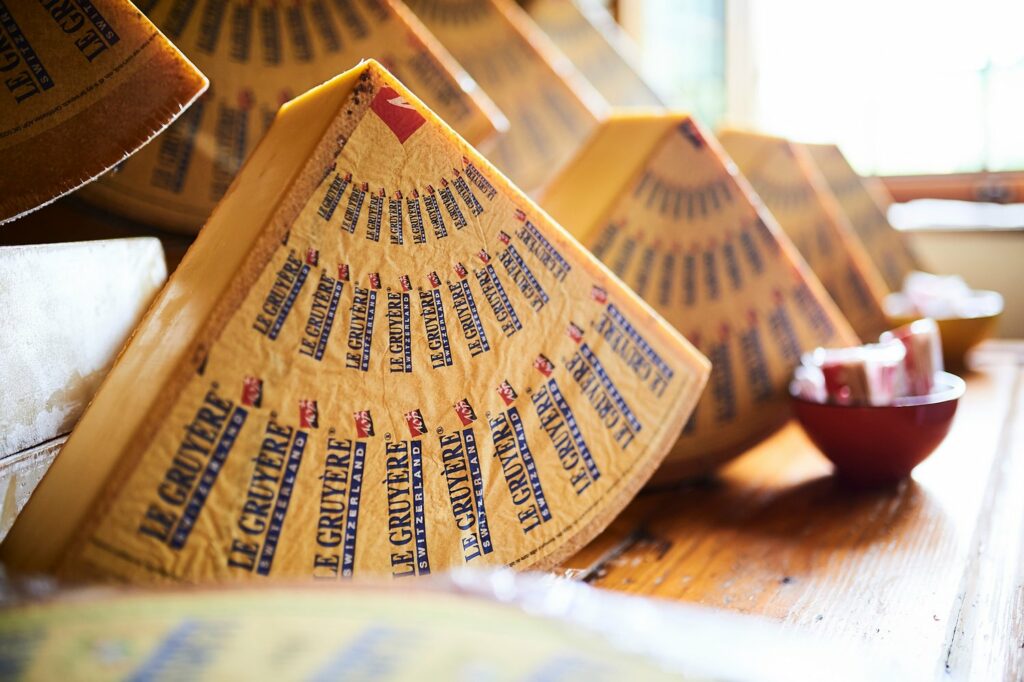What is Gruyère? The Swiss Alpine Cheese with a Sweet & Salty Twist

Welcome to a tantalizing journey through the world of cheese, where we embark on a culinary exploration of one of Switzerland’s most prized gastronomic treasures – Gruyère.
This Swiss marvel, known for its nutty flavor and creamy texture, has been enchanting cheese lovers for centuries, earning it the title of a true delicacy. Whether melted into fondue, grated over French onion soup, or simply savored on its own, Gruyère is a versatile delight that never fails to impress.
In this post, we will delve into the fascinating history, the intricate production process, and the unique flavor profile of this extraordinary cheese.
So, prepare your palate for an unforgettable journey as we unravel the secrets of Gruyère, the crowned jewel of Swiss cuisine.
Quick Facts about Gruyère
| Gruyère Quick Facts | Description |
|---|---|
| Origin | Switzerland |
| Milk Source | Cow’s milk |
| Texture | Hard, dense and smooth with few small holes |
| Flavor | Sweet but slightly salty, with flavor that varies widely with age. It is often described as creamy and nutty when young, becoming more assertive, earthy, and complex as it matures |
| Color | Pale yellow |
| Aging Process | Typically aged for 6 to 10 months, but can be aged for up to 14 months |
| Protected Designation of Origin | Gruyère has a Protected Designation of Origin (PDO) in Switzerland since 2001 |
| Historical Origins | The production of Gruyère dates back to the 12th Century |
| Uses | Widely used in cooking, particularly in baked dishes, fondues, and French onion soup. Also excellent on its own as a table cheese |
What is so special about Gruyère cheese?
Gruyère cheese, originating from Switzerland, holds a special place in the world of gourmet cuisines due to its unique characteristics and versatile nature.
Firstly, its flavor profile is quite distinctive. Gruyère has a rich, slightly nutty taste, opening with full-bodied, fruity tones, and then slowly transitioning towards earthy and nutty nuances. The flavor can vary depending on its age, with younger Gruyère having a milder, grassier flavor.
The texture of Gruyère is another remarkable feature. It has a firm texture that’s riddled with small cracks, which are smaller than the “eyes” found in many other types of cheese.
Despite being hard, Gruyère is well-known for its excellent melting properties, making it a popular choice in dishes like fondue and croque monsieur.
Moreover, there’s a special variety of Gruyère produced only in summer in the Swiss Alps, branded as Le Gruyère Switzerland AOC Alpage. This adds to its exclusivity and appeal.
The specialness of Gruyère cheese lies in its complex flavor profile, versatile texture, and the traditional, seasonal methods involved in its production.
What is Gruyère cheese similar to?
Gruyère cheese has a few close cousins in the world of cheese, thanks to its nutty flavor and smooth, meltable texture.
Here are a few types of cheese that are similar to Gruyère:
- Emmental: Also known as Swiss cheese, Emmental shares Gruyère’s origin in Switzerland. It has a similar nutty flavor, though it is slightly milder and sweeter. Emmental is distinguished by its large holes or “eyes”.
- Comté: This French cheese is often compared to Gruyère due to its similar production process and flavor profile. Comté is slightly sweeter and less nutty but shares the same smooth, creamy texture.
- Jarlsberg: This Norwegian cheese is sweeter and milder than Gruyère but shares a similar semi-hard texture. Jarlsberg also melts well, making it a good substitute in recipes.
- Beaufort: Another French cheese, Beaufort, is similar to Gruyère in both taste and texture. It has a slightly stronger, more aromatic flavor and is also excellent for melting.
Remember, while these cheeses share similarities with Gruyère, each one carries its unique nuances and characteristics that make it special in its own right.
What is the difference between Gruyère and Emmental cheese?
Gruyère and Emmental are both Swiss cheeses, but they have distinct differences in terms of flavor, texture, and production process.
Here’s a comparison of the two:
| Property | Gruyère | Emmental |
|---|---|---|
| Origin | Switzerland | Switzerland |
| Type | Hard cheese | Semi-hard cheese |
| Flavor | Nutty, slightly sweet, becomes more pronounced with age | Mild, slightly nutty and fruity |
| Texture | Dense, slightly grainy | Smooth with characteristic large holes or “eyes” |
| Aging Period | Typically aged for 5-12 months | Typically aged for 4-14 months |
| Uses | Fondue, quiche, gratins, sandwiches, cheese boards | Fondue, sandwiches, cheese boards |
| Pairings | White wines like Chardonnay, light-bodied red wines like Beaujolais | Light to medium-bodied red wines, fruit, bread |
Gruyère

Gruyère is named after the town of Gruyères in Switzerland. It has a dense and slightly grainy texture. The flavor is complex, with a creamy, nutty taste that becomes more pronounced as it ages. Gruyère is often used in cooking, where it adds depth and richness to dishes like fondue and quiche.
Emmental

Emmental, also known as Swiss cheese, is famous for its large holes or “eyes”. It has a smooth texture and a mild, slightly nutty and fruity flavor. Emmental is versatile – it can be used in cooking or eaten on its own with fruit and bread.
>> Click here to read our in-depth guide on Emmental
Is Gruyère similar to Mozzarella?
While Gruyère and Mozzarella are both delicious cheeses, they are not very similar in terms of flavor, texture, and usage.
| Property | Gruyère | Mozzarella |
|---|---|---|
| Origin | Switzerland | Italy |
| Type | Hard cheese | Soft cheese |
| Flavor | Nutty, slightly sweet, becomes more pronounced with age | Mild, slightly sweet |
| Texture | Dense, slightly grainy | Creamy, semi-elastic |
| Melting Properties | Melts smoothly, good for fondues and gratins | Stretches when melted, ideal for pizzas |
| Aging Period | Typically aged for 5-12 months | Eaten fresh, usually within a few hours to a week of production |
| Uses | Fondue, quiche, gratins, sandwiches, cheese boards | Pizza, caprese salad, lasagna, cheese boards |
| Pairings | White wines like Chardonnay, light-bodied red wines like Beaujolais | Light white wines like Pinot Grigio, tomato-based dishes |
Gruyère is a hard cheese with a complex, nutty flavor that becomes more pronounced as it ages. It has a dense and slightly grainy texture. This Swiss cheese is commonly used in dishes that require melting or baking, such as fondue, quiche, and gratins.
On the other hand, Mozzarella is a soft, semi-elastic Italian cheese known for its mild and slightly sweet flavor. It has a high moisture content and a creamy, delicate texture. Mozzarella is famous for its stretchy quality when melted, making it a top choice for pizza and caprese salad.
While both Gruyère and Mozzarella melt well and can be used in various dishes, they offer distinct flavors and textures that set them apart.
Is Gruyère a stinky cheese?
Gruyère isn’t typically classified as a ‘stinky’ cheese. It has a distinct aroma, but it’s not overpowering or off-putting. The smell of Gruyère is usually described as nutty or earthy, rather than pungent.
Stinky cheeses are those that have a strong, often pungent odor. Examples include Limburger, Epoisses, and some types of Blue cheese. These cheeses have been washed or aged in a way that promotes the growth of bacteria responsible for their strong smell.
Gruyère, on the other hand, is known for its complex flavor profile that’s slightly sweet, creamy, and nutty. As it ages, the flavor becomes more pronounced, but it doesn’t develop the pungent odor associated with stinky cheeses.
What is the Flavour of Gruyere cheese?
Gruyère cheese is known for its rich, nutty flavor. It has a slightly sweet taste that becomes more pronounced with age.
The cheese also has a creamy and smooth texture that makes it a favorite in many dishes.
Some people might detect notes of fruitiness or earthiness as well. Overall, Gruyère offers a complex flavor profile that sets it apart from other types of cheese.
Also read: How to ‘Taste’ Cheese Through the Nose
Why is Gruyère so expensive?
Gruyère cheese is more expensive than many cheeses for several reasons:
- Production Process: Gruyère is aged for a longer period of time compared to many other cheeses. It takes 5 to 15 months to produce, which contributes to its higher price.
- Quality Control: Gruyère has Appellation d’origine contrôlée (AOC) certification, meaning it must adhere to strict production methods and quality standards to bear the name.
- Versatility: Gruyère’s excellent melting qualities and rich, complex flavor make it a versatile cheese that can be used in a variety of dishes, from fondue and quiche to gratins and sandwiches. This versatility can add to its value.
- Import Tariffs: In countries like the US, tariffs on imported cheeses can significantly increase the cost of Gruyère.
- Protected Designation: Gruyère has AOP protection from the EU. This means that only cheese produced in certain regions using specific methods can be called “Gruyère”.
While Gruyère may be more expensive than other cheeses, its unique qualities and the meticulous process involved in its production often justify the cost.
What is the best way to eat Gruyère cheese? Pairing Guide
Here’s how to best enjoy this delicious Swiss cheese:
- In Cooking: Due to its excellent melting properties, Gruyère is a popular choice in many dishes. It’s a key ingredient in traditional Swiss fondue and is also used in quiches, gratins, and soufflés. Try it melted in a croque monsieur (a French-style grilled cheese sandwich with ham) or in a classic French onion soup.
- Cheese Board: Gruyère can be a star player on a cheese board. Pair it with fresh fruits like apples, pears, and grapes, or dried fruits like figs and apricots. Nuts, especially almonds and walnuts, complement its nutty flavor.
- Wine Pairing: When it comes to wine, Gruyère pairs well with a variety of options. Try it with a crisp white wine like a Sauvignon Blanc or a light red like Pinot Noir. If you prefer a more robust pairing, a full-bodied Chardonnay or an aged Burgundy will work very well.
- Beer Pairing: If you’re a beer lover, Gruyère pairs nicely with a range of beers. Try it with a Belgian-style ale, a stout, or even an IPA.
- With Bread: Gruyère is delicious simply sliced and eaten with a crusty baguette or a hearty sourdough.
- Dessert: Believe it or not, Gruyère can also be used in dessert! Try it with dark chocolate or baked into a savory-sweet tart with caramelized onions.
Also read: Best Wine and Cheese Pairings: The Ultimate Guide
Best food that goes well with Gruyère
| Food Category | Specific Foods |
|---|---|
| Breads | Baguette, Sourdough, Whole Grain Bread |
| Fruits | Apples, Pears, Grapes, Dried Apricots, Figs |
| Nuts | Almonds, Walnuts, Hazelnuts |
| Meats | Ham, Prosciutto, Salami |
| Vegetables | Broccoli, Cauliflower, Caramelized Onions |
| Desserts | Dark Chocolate, Honey |
| Other Cheeses | Camembert, Brie, Roquefort |
| Savory Dishes | Quiche, Fondue, Croque Monsieur, French Onion Soup |
Also read: What Fruit Goes on a Charcuterie Board?
Best beverage that goes well with Gruyère
| Beverage Category | Specific Beverages |
|---|---|
| White Wines | Sauvignon Blanc, Chardonnay |
| Red Wines | Pinot Noir, Burgundy |
| Beers | Belgian-style Ale, Stout, IPA |
| Non-Alcoholic | Apple Cider, Grape Juice |
| Spirits | Whisky, Brandy |
Also read: A Comprehensive Guide to Enjoying Cheese Platter with Wine
Is Gruyère a healthy cheese?
Like many cheeses, Gruyère can be part of a healthy diet when consumed in moderation. Here’s why:
- Nutrient-Rich: Gruyère is high in protein and calcium, nutrients that are essential for muscle function and bone health.
- Vitamin Source: It also contains vitamins such as vitamin A and vitamin B12.
However, there are some factors to consider:
- High in Fat and Sodium: Gruyère is high in fat and sodium, which can contribute to health issues like heart disease and high blood pressure if consumed in excess.
- Lactose Content: It’s not suitable for people with lactose intolerance.
The key is balance and moderation. It’s also important to consider the rest of your diet and lifestyle when thinking about whether a particular food is ‘healthy’ for you.
If you have specific dietary concerns or health conditions, it’s best to consult a dietitian or healthcare provider.
Also read: Savor the Flavor: 20 Cheeses with the Least Lactose
Gruyère Nutrition Facts
The nutritional facts for 100g of Gruyère cheese:
| Nutrition Facts | Amount |
|---|---|
| Calories | 413 |
| Fat | 30g |
| Sodium | 740mg |
| Carbohydrates | 0.4g |
| Protein | 30g |
| Calcium | 740mg |
| Vitamin B12 | 0.5mcg |
The pros and cons of Gruyère
Benefits:
- Versatile: Can be used in a variety of dishes due to its excellent melting properties.
- Flavorful: Has a rich, nutty flavor that can elevate many dishes.
- Nutrient-Rich: High in protein and calcium.
- Shelf Life: It’s a hard cheese, so it tends to have a longer shelf life than softer cheeses.
Drawbacks:
- High in Fat: Like most cheeses, Gruyère is high in saturated fats.
- High in Sodium: Contains a significant amount of sodium, which can contribute to high blood pressure if consumed in excess.
- Lactose: Not suitable for individuals who are lactose intolerant.
- Expensive: As a high-quality Swiss cheese, it can be more costly than other types of cheese.
The History of Gruyère
Gruyère cheese has a rich and fascinating history dating back centuries. The cheese originated in the mountainous town of Gruyères, Switzerland, giving it its geographic origins as a Swiss cheese.
The first records of Gruyère date back to medieval times, specifically 1115, when dairy farmers would make it to preserve their milk.
However, it wasn’t until 1655 that this famous hard cheese, which had been made from time immemorial, was given the name Gruyère.
In 2001, Gruyère gained the appellation d’origine contrôlée (AOC), which became the appellation d’origine protégée (AOP) as of 2013.
This designation is used to certify that a product comes from a specific region and meets certain quality standards. In the case of Gruyère, it signifies that the cheese is produced in the vicinity of La Gruyère in southern Switzerland and in the Alpine Comté and Savoie regions.
Over the centuries, Gruyère has maintained its traditional cheesemaking methods, contributing to its unique flavor and texture that is loved worldwide.
Frequently Asked Questions
1. Is Gruyère a type of Cheddar?
No, Gruyère is not a type of Cheddar. They are two distinct types of cheese with different origins, flavors, and textures.
Cheddar originated in the English village of Cheddar in Somerset. It’s a hard cheese with a sharper, often tangy flavor that deepens as it ages. Cheddar has a firm, smooth texture and is versatile in its uses, from sandwiches and burgers to macaroni and cheese.
2. Is Gruyère Swiss or Cheddar?
Gruyère is a type of Swiss cheese. It originates from the town of Gruyères in Switzerland, which gives it its name. It’s known for its rich, creamy, and slightly sweet flavor profile.
On the other hand, Cheddar is a type of English cheese that originates from the village of Cheddar in Somerset, England.
3. Can you eat Gruyère raw?
Yes, you can definitely eat Gruyère cheese raw. In fact, it’s often served this way on cheese platters or in sandwiches. It has a slightly granular texture and its flavor is rich, creamy, and nutty, which makes it a great cheese to enjoy raw.
It also melts well, which makes it a popular choice for fondue, gratins, and other cooked dishes. As with any cheese, just make sure it’s been stored properly and is not past its expiration date before you eat it.
4. How do you pronounce Gruyère?
Gruyère is pronounced as “groo-yair”. Here’s a breakdown:
- “groo”: rhymes with “zoo”
- “yair”: rhymes with “air”
5. Does Gruyère need to be refrigerated?
Yes, Gruyère cheese should be refrigerated. Once cut, it’s best to store Gruyère in the refrigerator to maintain its quality and prevent spoilage.
Wrap it in wax paper or cheese paper if you have it. If not, plastic wrap will also work.
The ideal temperature for storing cheese is between 35 and 45 degrees Fahrenheit (1.7 to 7.2 degrees Celsius).
Remember, cheese is a living product and needs to breathe, so it’s best not to wrap it too tightly.
Also read:
- A Guide to Provolone: A Masterclass in Flavor and Versatility
- Pecorino Romano: The Ultimate Guide to Italy’s Age-Old Cheese
- Utz Cheese Balls: The Ultimate Guide (Taste the Tradition)
- A Guide to Havarti: The Star Cheese of the Culinary World
- Savor the Flavor: 20 Cheeses with the Least Lactose
- Best Wine and Cheese Pairings: The Ultimate Guide
- Cheese Curds: The Unsung Heroes of the Dairy World





